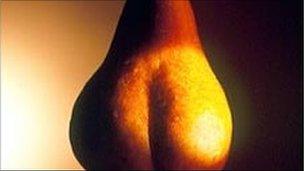'Pear-shaped' genes uncovered
- Published

The genes help determine body shape
The parts of our DNA which may influence body shape, including the classic "apple" or "pear" shape in women, have been revealed.
A UK study in Nature Genetics found the locations of 13 genes which may play a role, with a stronger effect in women.
Where body fat lies may affect diabetes and heart disease risk, so the results could shed light on those diseases.
A British Heart Foundation spokesman said the findings could lead to new dietary advice or medicines.
It is known that men and women who carry more fat around their waists compared with their bottoms and thighs are more prone to diabetes and heart disease - but the reason why fat accumulates in different places is far less clear.
The scientists, led by researchers at Oxford University and the Medical Research Council, looked at the genetic code of more than 77,000 people, looking for genetic regions which could be linked to differences in body fat distribution.
Although the 13 locations highlighted probably only account for a tiny fraction of the variation in the ratio between waist and hip, they are more likely to point towards the underlying body mechanisms which control fat storage.
Genes known to be involved in controlling cholesterol, insulin, and insulin resistance - linked to the development of diabetes - fall within the 13 regions.
'Stepping stone'
The fact that the effect of genes in these locations may be stronger for women than for men also intrigues the researchers.
Dr Cecilia Lindgren, of the Wellcome Trust Centre for Human Genetics at Oxford, said: "By finding genes that have an important role in influencing whether we are apple-shaped or pear-shaped, and the ways in which that differs between men and women, we hope to home in on the crucial underlying biological processes.
"Understanding biology through finding genes is just a first step in a long journey towards treatment, but it is a vital one."
A second, even bigger study looked for genetic variations connected to differences in "body mass index", the standard measure of weight vs height used as a guide to whether a person is a healthy weight.
They found 18 new genetic variants involved in people with higher BMI - in fact, people who inherited many of them weighed as much as 9kg (1st 5lbs) more than those who had only inherited a few.
Dr Ruth Loos, who led this study, said that the two studies combined may eventually lead to better ways to prevent obesity and even the development of new drugs.
Professor Jeremy Pearson, associate medical director at the British Heart Foundation, said: "We've known for some time that while fat anywhere in your body is not good for you, fat around the tummy increases your risk of heart disease and other illnesses more than fat around the bum.
"We've also known that the pattern for where our body stores fat is partly controlled by our genes, but only one of the genes responsible had been discovered.
"It's likely that several of these new genes will control the behaviour of fat cells. This will need to be confirmed with further research, but these findings are a good stepping stone towards how we might be able to offer new dietary advice or medicines to control the pattern of fat distribution in future."
- Published14 July 2010